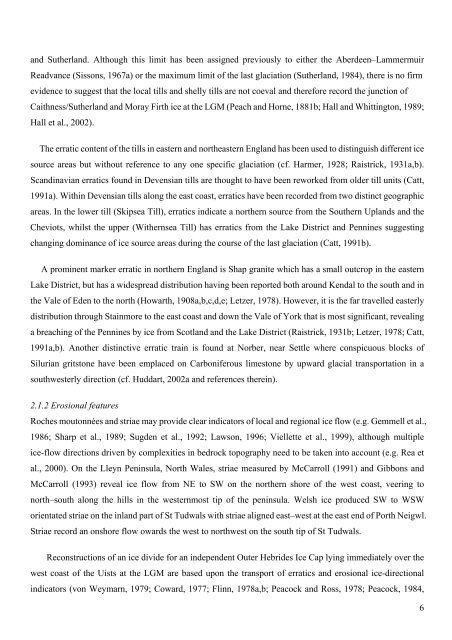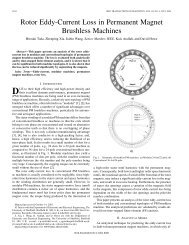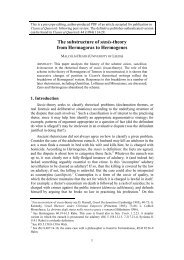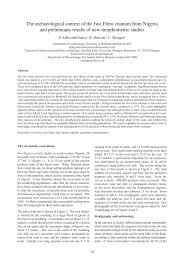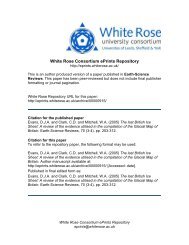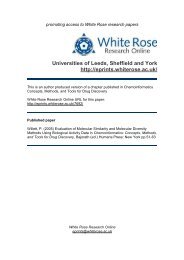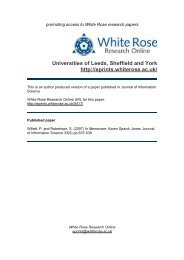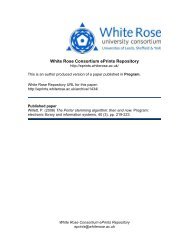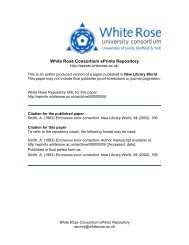The last British Ice Sheet: A review of the evidence utilised in the ...
The last British Ice Sheet: A review of the evidence utilised in the ...
The last British Ice Sheet: A review of the evidence utilised in the ...
You also want an ePaper? Increase the reach of your titles
YUMPU automatically turns print PDFs into web optimized ePapers that Google loves.
and Su<strong>the</strong>rland. Although this limit has been assigned previously to ei<strong>the</strong>r <strong>the</strong> Aberdeen–Lammermuir<br />
Readvance (Sissons, 1967a) or <strong>the</strong> maximum limit <strong>of</strong> <strong>the</strong> <strong>last</strong> glaciation (Su<strong>the</strong>rland, 1984), <strong>the</strong>re is no firm<br />
<strong>evidence</strong> to suggest that <strong>the</strong> local tills and shelly tills are not coeval and <strong>the</strong>refore record <strong>the</strong> junction <strong>of</strong><br />
Caithness/Su<strong>the</strong>rland and Moray Firth ice at <strong>the</strong> LGM (Peach and Horne, 1881b; Hall and Whitt<strong>in</strong>gton, 1989;<br />
Hall et al., 2002).<br />
<strong>The</strong> erratic content <strong>of</strong> <strong>the</strong> tills <strong>in</strong> eastern and nor<strong>the</strong>astern England has been used to dist<strong>in</strong>guish different ice<br />
source areas but without reference to any one specific glaciation (cf. Harmer, 1928; Raistrick, 1931a,b).<br />
Scand<strong>in</strong>avian erratics found <strong>in</strong> Devensian tills are thought to have been reworked from older till units (Catt,<br />
1991a). With<strong>in</strong> Devensian tills along <strong>the</strong> east coast, erratics have been recorded from two dist<strong>in</strong>ct geographic<br />
areas. In <strong>the</strong> lower till (Skipsea Till), erratics <strong>in</strong>dicate a nor<strong>the</strong>rn source from <strong>the</strong> Sou<strong>the</strong>rn Uplands and <strong>the</strong><br />
Cheviots, whilst <strong>the</strong> upper (Wi<strong>the</strong>rnsea Till) has erratics from <strong>the</strong> Lake District and Penn<strong>in</strong>es suggest<strong>in</strong>g<br />
chang<strong>in</strong>g dom<strong>in</strong>ance <strong>of</strong> ice source areas dur<strong>in</strong>g <strong>the</strong> course <strong>of</strong> <strong>the</strong> <strong>last</strong> glaciation (Catt, 1991b).<br />
A prom<strong>in</strong>ent marker erratic <strong>in</strong> nor<strong>the</strong>rn England is Shap granite which has a small outcrop <strong>in</strong> <strong>the</strong> eastern<br />
Lake District, but has a widespread distribution hav<strong>in</strong>g been reported both around Kendal to <strong>the</strong> south and <strong>in</strong><br />
<strong>the</strong> Vale <strong>of</strong> Eden to <strong>the</strong> north (Howarth, 1908a,b,c,d,e; Letzer, 1978). However, it is <strong>the</strong> far travelled easterly<br />
distribution through Sta<strong>in</strong>more to <strong>the</strong> east coast and down <strong>the</strong> Vale <strong>of</strong> York that is most significant, reveal<strong>in</strong>g<br />
a breach<strong>in</strong>g <strong>of</strong> <strong>the</strong> Penn<strong>in</strong>es by ice from Scotland and <strong>the</strong> Lake District (Raistrick, 1931b; Letzer, 1978; Catt,<br />
1991a,b). Ano<strong>the</strong>r dist<strong>in</strong>ctive erratic tra<strong>in</strong> is found at Norber, near Settle where conspicuous blocks <strong>of</strong><br />
Silurian gritstone have been emplaced on Carboniferous limestone by upward glacial transportation <strong>in</strong> a<br />
southwesterly direction (cf. Huddart, 2002a and references <strong>the</strong>re<strong>in</strong>).<br />
2.1.2 Erosional features<br />
Roches moutonnées and striae may provide clear <strong>in</strong>dicators <strong>of</strong> local and regional ice flow (e.g. Gemmell et al.,<br />
1986; Sharp et al., 1989; Sugden et al., 1992; Lawson, 1996; Viellette et al., 1999), although multiple<br />
ice-flow directions driven by complexities <strong>in</strong> bedrock topography need to be taken <strong>in</strong>to account (e.g. Rea et<br />
al., 2000). On <strong>the</strong> Lleyn Pen<strong>in</strong>sula, North Wales, striae measured by McCarroll (1991) and Gibbons and<br />
McCarroll (1993) reveal ice flow from NE to SW on <strong>the</strong> nor<strong>the</strong>rn shore <strong>of</strong> <strong>the</strong> west coast, veer<strong>in</strong>g to<br />
north–south along <strong>the</strong> hills <strong>in</strong> <strong>the</strong> westernmost tip <strong>of</strong> <strong>the</strong> pen<strong>in</strong>sula. Welsh ice produced SW to WSW<br />
orientated striae on <strong>the</strong> <strong>in</strong>land part <strong>of</strong> St Tudwals with striae aligned east–west at <strong>the</strong> east end <strong>of</strong> Porth Neigwl.<br />
Striae record an onshore flow owards <strong>the</strong> west to northwest on <strong>the</strong> south tip <strong>of</strong> St Tudwals.<br />
Reconstructions <strong>of</strong> an ice divide for an <strong>in</strong>dependent Outer Hebrides <strong>Ice</strong> Cap ly<strong>in</strong>g immediately over <strong>the</strong><br />
west coast <strong>of</strong> <strong>the</strong> Uists at <strong>the</strong> LGM are based upon <strong>the</strong> transport <strong>of</strong> erratics and erosional ice-directional<br />
<strong>in</strong>dicators (von Weymarn, 1979; Coward, 1977; Fl<strong>in</strong>n, 1978a,b; Peacock and Ross, 1978; Peacock, 1984,<br />
6


